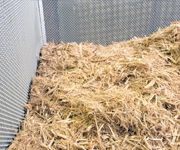Ethanol Fuel Basics

Ethanol is a renewable fuel made from various plant materials collectively known as "biomass." More than 98% of U.S. gasoline contains ethanol to oxygenate the fuel. Typically, gasoline contains E10 (10% ethanol, 90% gasoline), which reduces air pollution.
Ethanol is also available as E85 (or flex fuel), which can be used in flexible fuel vehicles, designed to operate on any blend of gasoline and ethanol up to 83%. Another blend, E15, is approved for use in model year 2001 and newer light-duty vehicles.
There are several steps involved in making ethanol available as a vehicle fuel:
- Biomass feedstocks are grown, collected, and transported to an ethanol production facility.
- Feedstocks are converted to ethanol at a production facility and then transported to a fuel terminal or end-user by rail, truck, or barge.
- E10 is sourced from fuel terminals whereas E85 is sourced from a terminal or directly from an ethanol production facility.
- E15 is available from fuel terminals or through a blender pump dispenser that draws from E10 and E85 tanks at a station.
Fuel Properties
Ethanol (CH3CH2OH) is a clear, colorless liquid. It is also known as ethyl alcohol, grain alcohol, and EtOH (see Fuel Properties search.) Ethanol has the same chemical formula regardless of whether it is produced from starch- or sugar-based feedstocks, such as corn grain (as it primarily is in the United States), sugar cane (as it primarily is in Brazil), or from cellulosic feedstocks (such as wood chips or crop residues).
Ethanol has a higher octane number than gasoline, providing premium blending properties. Minimum octane number requirements for gasoline prevent engine knocking and ensure drivability. Lower-octane gasoline is blended with 10% ethanol to attain the standard 87 octane.
Ethanol contains less energy per gallon than gasoline, to varying degrees, depending on the volume percentage of ethanol in the blend. Denatured ethanol (98% ethanol) contains about 30% less energy than gasoline per gallon. Ethanol’s impact on fuel economy is dependent on the ethanol content in the fuel and whether an engine is optimized to run on gasoline or ethanol.
Ethanol Energy Balance
In the United States, 94% of ethanol is produced from the starch in corn grain. Energy is required to turn any raw feedstock into ethanol. Ethanol produced from corn demonstrates a positive energy balance, meaning that the process of producing ethanol fuel does not require more energy than the amount of energy contained in the fuel itself.
Cellulosic ethanol improves the energy balance of ethanol because the feedstocks are either waste, coproducts of another industry (wood, crop residues), or dedicated crops—such as switchgrass and miscanthus—with lower water and fertilizer requirements compared to corn. When biomass is used to power the process of converting non-food-based feedstocks into cellulosic ethanol, the amount of fossil fuel energy used in production is reduced even further. Another benefit of cellulosic ethanol is that it results in lower levels of life cycle greenhouse gas emissions.
For more information on the energy balance of ethanol, download the following documents:
- USDA's 2018 – A Life-Cycle Analysis of the Greenhouse Gas Emissions from Corn-Based Ethanol
- Argonne National Laboratory's GREET Model (Greenhouse Gases, Regulated Emissions, and Energy Use in Transportation Model)
- USDA's 2015 – Energy Balance for the Corn-Ethanol Industry